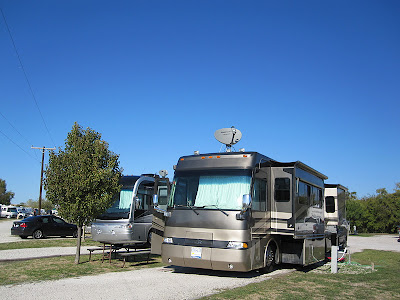We stayed at Retama Village in Mission. Retama Village is located within the 2,500-acre Bentsen Palm Development Master Planned Community in Mission and has access to the multitude of ecological wonders surrounding this very special community. Located within walking distance are the World Birding Center Headquarters at Bentsen-RGV State Park (the top birding sight in the U.S.), the North American Butterfly Association’s new International Butterfly Park (the largest outdoor butterfly park in the world), and thousands of acres of state and federally protected pristine wildlife habitat including lakes, parks, and the Rio Grande River.
Retama is an interesting mix of luxury RV sites with cabana or upscale RV homes and regular homes all surrounding a large clubhouse and pools.
We went to the National Butterfly Center and also to the Bird Sanctuary, both were really interesting and worth while trips. The butterfly park has over 5 acres of gardens designed to attract butterflies. We got to meet several of the over 100 varieties of butterflies that routinely make the Valley their winter home.
We also got to see some of the rare species of birds that are rarely found elsewhere, including one that we thought was right from the Jurrasic Park movie. We tried to get some better pictures of it, but it was fast and elusive, especially when it ran up the trees.
After a week in Mission we headed east along the Rio Grande and then north to Corpus Christi. It is the 5th largest port in the US and we routinely saw large tankers and freighters heading out to sea. We had a great time playing on the beach and in the surf on Mustang and Padre Island. One day we drove out to the beach with new friends we found in our RV park who were from Port Hardy.
We could see oil drilling platforms out in the Bay and the tankers heading out to service them.
Along the many marinas of Corpus Christi we found some very interesting and big yachts but also an actual replica of Christopher Columbus' ship the Pina. This was built by the historical society according to the standards, materials and sizes that the original was built in 1492. This ship was sailed from Portugal by the society to the "new world" and has now found a home in Corpus Christi. It was unbelievable that a ship this small made it on one of the most famous voyages in 1492.
On our last day we visited and toured the USS Lexington which has now been permanently berthed in Corpus Christi, having retired from the Navy in 1991. The Lexington is known as "The Blue Ghost" and is one of 24 Essex-class aircraft carriers built during World War II for the United States Navy. The Lexington was given the nickname "The Blue Ghost" by the Japanese. Part of the reason for the nickname the "Blue Ghost" was the fact that Lexington was painted dark blue, and was the only carrier not to wear camouflage. This aspect was used to demoralize the Japanese, as they could not sink Lexington since she was believed to be so heavily defended. The "ghost" portion of the nickname comes from the fact that the Japanese believed that they had sunk the Lexington no less than four times during the course of the war, leading Tokyo Rose to give the ship its nickname.
We toured the entire ship including the hanger deck, Captain and Admiral's quarters, the Bridge and below decks. Here's Susan on the Bridge.
And Kerry besides a Cobra Helicopter,
We then headed back to Fort Worth where we caught a plane to fly to Mexico and the Mayan Riviera to visit Judy and Eric, Trevor and Shannon, Kyle and Mya. We had a great time, the weather was perfect and the company better.
We also met some interesting animals, including the Lemur and the Iguana.
A great time had by all. Judy and Eric are staying down an additional week, however we returned to Fort Worth to collect our boys and head off into New Mexico. We've spent about a month in Texas and now we are making our move into the West.
































































